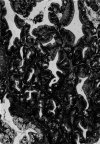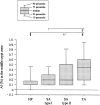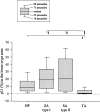Different apoptotic activity and p21(WAF1/CIP1), but not p27(Kip1), expression in serrated adenomas as compared with traditional adenomas and hyperplastic polyps of the colorectum
- PMID: 12884030
- PMCID: PMC12161972
- DOI: 10.1007/s00432-003-0478-y
Different apoptotic activity and p21(WAF1/CIP1), but not p27(Kip1), expression in serrated adenomas as compared with traditional adenomas and hyperplastic polyps of the colorectum
Abstract
Purpose: Serrated adenomas (SAs), which include a wide spectrum of lesions, can be broadly divided into two subtypes: type I, closely mimicking hyperplastic polyps (HPs), and type II, unequivocal adenomatous tumor. Our preliminary findings showed clinicopathologic differences between them. The present study was conducted to investigate apoptotic activity and expression of the cell cycle regulator proteins p21(WAF1/CIP1) and p27(Kip1) in type I and II SAs, as compared with traditional adenomas (TAs) and HPs.
Methods: Apoptotic activity was estimated in hematoxylin-eosin stained specimens, and p21(WAF1/CIP1) or p27(Kip1) immunoreactivity was determined in 62 SAs (19 type I and 43 type II), 50 TAs and 19 HPs. The numbers (percentages) of apoptotic or immunoreactive cells were counted per 1,000 epithelial cells in equally separated crypt zones (upper, middle, and lower thirds).
Results: The apoptotic activity in the middle, but not the upper or lower crypt zone was higher in type II SAs (median 0.2%, interquartile range 0.1-0.5%) than in HPs (0.1%, 0.1-0.2%, P<0.01), whereas it was lower in type I SAs (0.2%, 0.1-0.3%) than in TAs (0.5%, 0.2-0.6%, P<0.001). P21(WAF1/CIP1) expression in the lower crypt zone was higher in both type I and type II SAs (19.8%, 7.0-33.2% and 20.4%, 3.9-47.8%, P<0.0001) than in TAs (1.2%, 0.6-5.2%), and a similar tendency was also observed for the middle crypt zone. p27(Kip1) expression did not vary among the groups.
Conclusions: The differences in apoptotic activity and p21(WAF1/CIP1) expression between SAs and TAs or HPs indicate that SA should be considered as a distinct subtype of colorectal neoplasm. The two subtypes of SA do not differ in these parameters despite specific clinicopathological features.
Figures






Similar articles
-
Expression patterns of cyclins D1, E and cyclin-dependent kinase inhibitors p21(Waf1/Cip1) and p27(Kip1) in urothelial carcinoma: correlation with other cell-cycle-related proteins (Rb, p53, Ki-67 and PCNA) and clinicopathological features.Urol Int. 2004;73(1):65-73. doi: 10.1159/000078807. Urol Int. 2004. PMID: 15263796
-
Status of p53 phosphorylation and function in sensitive and resistant human cancer models exposed to platinum-based DNA damaging agents.J Cancer Res Clin Oncol. 2003 Dec;129(12):709-18. doi: 10.1007/s00432-003-0480-4. Epub 2003 Sep 26. J Cancer Res Clin Oncol. 2003. PMID: 14513366 Free PMC article.
-
p21WAF1/CIP1 is more effective than p53 in growth suppression of mouse renal carcinoma cell line Renca in vitro and in vivo.J Cancer Res Clin Oncol. 2003 Aug;129(8):463-71. doi: 10.1007/s00432-003-0458-2. Epub 2003 Jul 15. J Cancer Res Clin Oncol. 2003. PMID: 12884025 Free PMC article.
-
Changing pathological diagnosis from hyperplastic polyp to sessile serrated adenoma: systematic review and meta-analysis.Eur J Gastroenterol Hepatol. 2017 Dec;29(12):1327-1331. doi: 10.1097/MEG.0000000000000994. Eur J Gastroenterol Hepatol. 2017. PMID: 29049128
-
Dietary fibre for the prevention of recurrent colorectal adenomas and carcinomas.Cochrane Database Syst Rev. 2017 Jan 8;1(1):CD003430. doi: 10.1002/14651858.CD003430.pub2. Cochrane Database Syst Rev. 2017. PMID: 28064440 Free PMC article.
Cited by
-
Cyclooxygenase-2 overexpression is common in serrated and non-serrated colorectal adenoma, but uncommon in hyperplastic polyp and sessile serrated polyp/adenoma.BMC Cancer. 2008 Jan 29;8:33. doi: 10.1186/1471-2407-8-33. BMC Cancer. 2008. PMID: 18230181 Free PMC article.
-
Up-regulation of c-MYC and SIRT1 expression correlates with malignant transformation in the serrated route to colorectal cancer.Oncotarget. 2012 Oct;3(10):1182-93. doi: 10.18632/oncotarget.628. Oncotarget. 2012. PMID: 23045412 Free PMC article.
-
A significant imbalance in mitosis versus apoptosis accelerates the growth rate of sessile serrated adenoma/polyps.Virchows Arch. 2013 Feb;462(2):131-9. doi: 10.1007/s00428-012-1365-1. Epub 2013 Jan 6. Virchows Arch. 2013. PMID: 23292000
-
Proliferation, apoptosis and their regulatory protein expression in colorectal adenomas and serrated lesions.PLoS One. 2021 Nov 11;16(11):e0258878. doi: 10.1371/journal.pone.0258878. eCollection 2021. PLoS One. 2021. PMID: 34762658 Free PMC article.
-
Nomenclature, molecular genetics and clinical significance of the precursor lesions in the serrated polyp pathway of colorectal carcinoma.Int J Clin Exp Pathol. 2008 Jan 1;1(4):317-24. Int J Clin Exp Pathol. 2008. PMID: 18787610 Free PMC article.
References
-
- Akino F, Mitomi H, Nakamura T, Ohtani Y, Ichinoe M, Okayasu I (2002) High apoptotic activity and low epithelial cell proliferation with underexpression of p21WAF1/CIP1 and p27Kip1 of mucinous carcinomas of the colorectum. Comparison with well-differentiated type. Am J Clin Pathol 117:908–915 - PubMed
-
- Ansari B, Coates PJ, Greenstein BD, Hall PA (1993) In situ end-labelling detects DNA strand breaks in apoptosis and other physiological and pathological states. J Pathol 170:1–8 - PubMed
-
- Ban S (1999) Small hyperplastic polyps of the colorectum showing deranged cell organization: a lesion considered to be a serrated adenoma? Am J Surg Pathol 23:1158–1160 - PubMed
-
- Ciaparrone M, Yamamoto H, Yao Y, Sgambato A, Cattoretti G, Tomita N, Monden T, Rotterdam H, Weinstein IB (1998) Localization and expression of p27KIP1 in multistage colorectal carcinogenesis. Cancer Res 58:114–122 - PubMed
Publication types
MeSH terms
Substances
LinkOut - more resources
Full Text Sources
Medical
Miscellaneous

